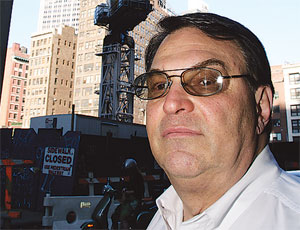The criminal prosecution of James F. Lomma, a prominent crane owner with offices in New York, New Jersey and Pennsylvania, swivels on the failure of a Chinese rotator gear, the hold-down welding of which catastrophically snapped in May 2008, sending steel debris raining onto the streets of Manhattan’s Upper East Side. The event killed two construction workers. In an earlier Lomma crane collapse in midtown Manhattan in March 2008, seven people died; a rigging company was indicted for manslaugheter in that case. The charges also fire a warning shot over the boardrooms of construction firms across America: Equipment owners may be held personally liable—even if safety regulators in their official investigation are unable to find code violations.


“I told my daughter that when she grows up, she should not be a CEO,” says Paul Shechtman, an attorney representing Lomma’s rental firm New York Crane and trucking outfit J.F. Lomma Inc. “There seems to be an automatic assumption that the CEO is the captain of the ship and that means criminal liability, and that notion is just not the law,” Shechtman says.
Lomma, 64, the two firms and a former employee, Tibor Varganyi, 63, have pleaded not guilty to charges of second-degree manslaughter, second-degree assault, criminally-negligent homicide and second-degree reckless endangerment; all the parties have posted bail. The indictment, unsealed on March 8, “is an important step not only in holding these defendants accountable for their conduct, but should send a message to the construction industry that profit cannot be put ahead of safety,” says Manhattan district attorney Cyrus R. Vance Jr. The case could go to trial as early as this summer or next fall, Shechtman says.
In addition to placing a construction accident at center stage in criminal court, the Lomma case may open up more owners of construction firms—big or small—to higher levels of scrutiny. “The real wake-up call to owners is that it’s not business as usual. They have to take ownership of safety and the operations of their equipment,” says one industry insider, who asked not to be identified.
"This is a very tragic situation," adds Frank Bardonaro, president and CEO of Trevose, Pa.-based AmQuip Crane Rental LLC and chairman of the Specialized Carriers & Rigging Association�s tower-crane committee. Bardonaro says the case raises new liability issues for crane owners, especially if construction markets ban the use of older cranes.
"I do believe you are going to see cities and governments outlawing machines that are no longer represented by a manufacturer," Bardonaro says, adding that it is common for crane parts to come from global sources. "Ultimately, this tragedy was caused by a poor manufacturing decision, not a poor rental company decision."
Lomma also belongs to SC&RA, a national crane-owner group.
"SC&RA has long been an ardent advocate for risk management, training and certification for crane operators as well as viable standards for crane operation," says Joel Dandrea, executive vice president, in a written statement. "If the case before the New York State Supreme Court serves any purpose, we hope it is to heighten the industry¹s commitment to safety."
Regulators have outlawed Kodiak-brand cranes since the collapse, yet a handful of Lomma’s other cranes are still in use, including two rigs working at One World Trade Center. “These tower cranes have been subject to our strict new requirements and protocols,” says Tony Sclafani, spokesman for the city’s buildings department. “That includes the requirement of a third-party inspection.”
Investigators with the U.S. Occupational Safety and Health Administration did not find violations directly tied to the crane failure, but the agency assisted in the criminal probe. The Kodiak collapse killed 30-year-old Donald C. Leo, who was operating the rig at the time, and Ramadan Kurtaj, 27, a sewer technician working nearby. Like many rental outfits, Lomma had rented out the crane “bare,” meaning without any staff. “How I feel about Jimmy Lomma being taken away in handcuffs, I say it’s a start,” says Donald R. Leo, 51, the operator’s father, who is suing Lomma, New York City and others for negligence in New York Supreme Court.
Criminal prosecutors allege that Lomma asked Varganyi, a mechanic with expertise in Kodiak-brand cranes, to seek out replacement gear in 2007 after the original part cracked. Since the crane was no longer in production, Varganyi solicited aftermarket bids, settling on a part from China-based RTR Bearing for about $20,000 with a three-month delivery. Two “reputable” firms also said they could build it for $34,000 and $120,000, respectively, in seven months and two years.
Forensic evidence shows a structural weld made by RTR, which allegedly had warned Lomma that it lacked “confidence on this welding,” failed catastrophically. “Without conducting due diligence on this unknown company, the defendants relied on RTR’s unverified representations on their Website,” prosecutors say, adding that Lomma and his associates gave RTR “grossly inadequate welding specifications” and did not follow generally accepted industry standards to ensure the weld was safe. “The Leo family has paid the ultimate price for Jimmy Lomma’s greed,” adds Bernadette Panzella, a lawyer representing Leo’s estate.
Lomma says he had the gear inspected properly—that city officials even signed off on it. “If anybody knows that cranes can be dangerous, it is Jimmy Lomma,” says Shechtman. “He had no interest or incentive in doing anything here but putting an operable crane back to work.”


Post a comment to this article
Report Abusive Comment